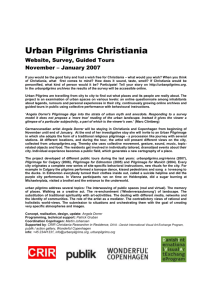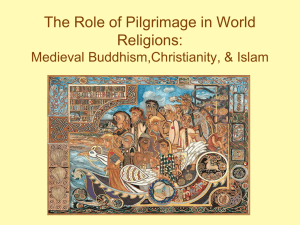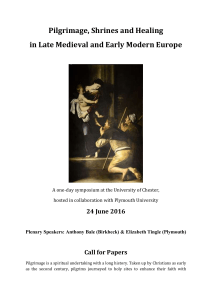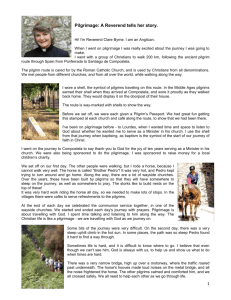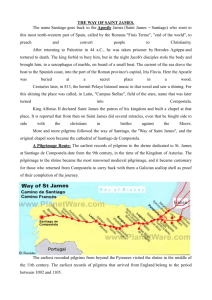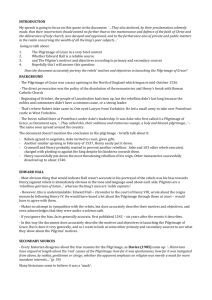Reader, Ian and Tony Walter (edts) 1993. Pilgrimage in Popular
advertisement
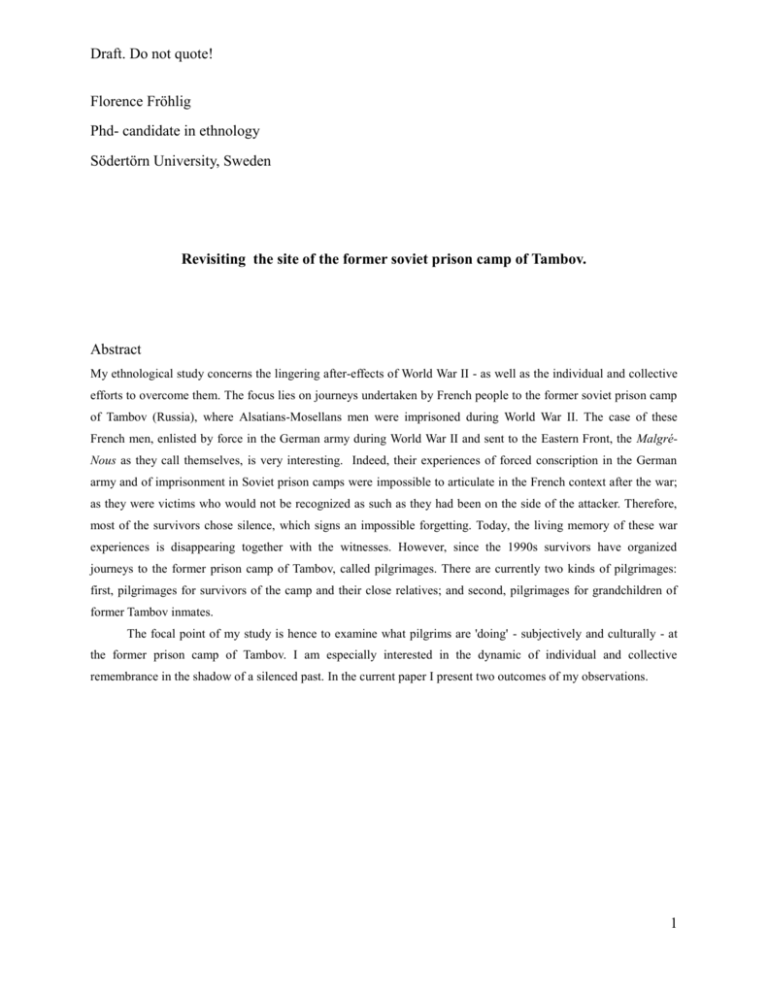
Draft. Do not quote! Florence Fröhlig Phd- candidate in ethnology Södertörn University, Sweden Revisiting the site of the former soviet prison camp of Tambov. Abstract My ethnological study concerns the lingering after-effects of World War II - as well as the individual and collective efforts to overcome them. The focus lies on journeys undertaken by French people to the former soviet prison camp of Tambov (Russia), where Alsatians-Mosellans men were imprisoned during World War II. The case of these French men, enlisted by force in the German army during World War II and sent to the Eastern Front, the MalgréNous as they call themselves, is very interesting. Indeed, their experiences of forced conscription in the German army and of imprisonment in Soviet prison camps were impossible to articulate in the French context after the war; as they were victims who would not be recognized as such as they had been on the side of the attacker. Therefore, most of the survivors chose silence, which signs an impossible forgetting. Today, the living memory of these war experiences is disappearing together with the witnesses. However, since the 1990s survivors have organized journeys to the former prison camp of Tambov, called pilgrimages. There are currently two kinds of pilgrimages: first, pilgrimages for survivors of the camp and their close relatives; and second, pilgrimages for grandchildren of former Tambov inmates. The focal point of my study is hence to examine what pilgrims are 'doing' - subjectively and culturally - at the former prison camp of Tambov. I am especially interested in the dynamic of individual and collective remembrance in the shadow of a silenced past. In the current paper I present two outcomes of my observations. 1 Draft. Do not quote! Florence Fröhlig Phd- candidate in ethnology Södertörn University, Sweden Draft. Do not quote! Revisiting the site of the former soviet prison camp of Tambov. My ethnographic research is about journeys undertaken by French people to the former soviet prison camp of Tambov (Russia). To understand their agency, we have to go back to 1940, when Germany de facto annexed three French neighbouring territories. After the battle of Stalingrad in 1942, the Nazis, short of men at the Eastern Front decided, to enlist by force over 130 000 young men from Alsace and Moselle in the German Army (Wehrmacht). Enlistment was forced in the sense that the parents were made responsible if the conscript was insubordinate or deserted. Most of the men were sent to the Eastern Front and ended up in Soviet prison camps as a result of desertion or arrest. Amongst all prison camps, that of Tambov became the symbol of the cruel fate which was reserved for them: hunger, cold, illness, forced job, neglect (the last Alsatian came back only in 1955). These men, calling themselves ‘Les Malgré-Nous’, the ‘Against-our-will’ (AOW), are the “shamefaced soldiers” who ended war in the uniform of the aggressors and who carried the physical and psychical stigmata (wounds) of their internment in the Soviet prison camps. After the end of the war, the non-recognition of their experience and suffering led to feelings of anger and frustration. These feelings were difficult to articulate as they were victims who would not be recognized as such since they had been to the side of the aggressor; therefore most of the survivors chose silence. 2 Draft. Do not quote! At the turn of the century, the living memory of this event is disappearing together with the witnesses. However, since the 1990s journeys to the former prison camp of Tambov, called pilgrimages, have been organized. The first pilgrimage took place in September 1995 at the initiative of some survivors, who had been scandalized during a private journey to the former prison camp to discover that nothing of their tragic past could be seen. In 1996, a special subgroup for the third generation was created within the association, with the explicit aim to achieve a memorial site for the prisoners of war (POW) in the forest of Rada. During the first Youth pilgrimage in 1996 a space on the site of one of the mass graves was chosen and marked off in agreement with the local Russian authorities, to organize a memorial site. The pilgrimages succeeded one another every year until 2000 and every two years after that. To differentiate the two sorts of pilgrimage, it is used to speak about the pilgrimage of the Ancients, called as such since the pilgrimages were firstly intended for the survivors of the camp and the pilgrimage of the Youth, even if all the participants are not that young. My research is based on three of these pilgrimages in which I took part: two Youth pilgrimages (in 2008 and 2010), and one of the Ancients pilgrimage in 2010. Both the Youth pilgrimages were subsidized for 17 people and attracted people between 18 and 40 years old with a predominance of male participants. The pilgrimage of the Ancients gathered together in 2010, 49 people between 22 and 86 years old (28 men and 21 women). The pilgrimage brought together three generations: survivors or contemporary (a wife and a sister of former POWs), children (of survivors or dead POWs, nephews and nieces) and two grandchildren. Here it should be mentioned that some participants are bearer of direct memories of the events, while others are bearer of postmemories (Hirsh 2001), but their agency indicates an effort to have that past make sense in the situation of their collective present. The journeys took place in August. Pilgrims gathered at the railway station in Strasbourg to take a bus to the airport of Frankfurt-Hahn, before taking a flight to Moscow where they took a night train to Tambov. I distinguished two sorts of activities during the journeys: the activities related to “Russia in the past” and the activities related to “Russia in the present”. By “Russia in the past” I view the visits to and the commemorative ceremonies on memorials sites and the work of maintenance of the French Square. Indeed every day such a sequence was included in the planning of all the pilgrimages but not necessarily in the same order. The second sorts of activities related to “Russia in the present” corresponds to the pilgrims’ experience of 3 Draft. Do not quote! Russia in a contemporary time frame: official receptions by local politicians, touristic activities and through informal interaction with the local population. In my thesis, I try to understand what people are 'doing' – subjectively and culturally- at Tambov, a place that the scholars in Heritage Management, Gregory Ashworth and John Tumbridge (2007) would have defined as a negative heritage place, a place concerned with human atrocity. In the current paper I will content myself to present two outcomes of the pilgrimage. The constitution of a tangible and intangible heritage During the journeys to Tambov, participants are engaging with a sense of history. I suggest that the pilgrims are constructing a dissonant heritage (Ashworth & Tumbridge 2007). Thus visiting and engaging with the heritage of Tambov is a cultural and political statement as well as an act of remembering (see also Smith 2006:66). Their agency is a clear challenge to the paradigm of the French war remembrance, in which the experience of the Alsatian/Mosellan POWs cannot be articulated. The memory contained in the ceremonies can be viewed as a response to or a dialog with the way commemoration of World War II is done in France. The French discourse of the past tells “nationalizing stories that simply do not reflect the cultural or social experiences of subaltern groups" (Smith 2006:36). Pilgrims, as a group, question the hegemonic role of the nation as an interpretative frame for the collective memory. They can be viewed as engaged in the political struggle for the recognition of the non-represented memories, i.e. ignored or undervalued to obtain a place within the official remembrance of World War II. Indeed the war has been remembered and commemorated in the paradigm of the national frame, in which the memories of the POWs could not be expressed, since they did not conform to the heroic image of the French resistance cultivated by official history. What is at stake here is the fact that the winners of war write history and determine heritage. Above all, heritage is almost inevitably about "goods things, events and cultural and communal pride in identity" (Smith 2006: 58). Furthermore, as Smith pointed out, the heritage discourse within the narrative of nation, explicitly promotes the experience and values of elite social classes, in which the experiences of ordinary soldiers of modest background do fit in (Smith 2006:30). The agency of the participant 4 Draft. Do not quote! in the pilgrimage can thus be seen as a claim of the 'excluded of history' (or person feeling excluded) facing the state representing the 'winner of history'. Thus the explicit purpose of the journey, is to remember “ceux qui nous suppliaient de ne pas les oublier” (the one, who begged us not to forget them). In others words, the purpose of the pilgrimage is to pay tribute to the Alsatians/Mosellans forced conscripts fallen on the East Front. This purpose is achieved through two means: the creation of a memorial site (and its maintenance) and the participation in the pilgrimage and its commemorative ceremonies. Tangible heritage The creation of a memorial site is a purposeful and intentional act aimed to materialize the past and to constitute a tangible heritage. The memorial is not only a physical reminder that people were buried at this precise location but it shows also that someone does care about the dead. For the pilgrims the construction of a monument can be seen as an attempt to reconstruct the past in the “enduringness of materials” but at the same time it can function as a catalysts for remembrance, it bridges back into the past and attests that this past should be held in public awareness rather than be forgotten (Ricoeur 2005:150). The shrine, as the anthropologist Ian Reader suggested, “enables people to crystallize and affirm their images of the past” (Reader 1993:252). In this sense, the monument in the forest of Rada acts as a reminder for the future. Indeed, monuments and memorials, as well as rituals, act as a reminder of an event transgenerationally with physical signs or re-enactments. Therefore, monuments connect together place and time: place is given an historical signification and history is given a spatial dimension (Kverndokk 2007: 263). This gives them a double function: they become reminder of the past and at the same time; they remind the passers-by of the significance of the past, which is associated with the monument (Eriksen 1999:95). The place is made here French by the pilgrims. First, it has to be reminded that the current memorial site is not located on the original location of the prison camp but on one of the mass grave. If any Alsatian/Mosellan men are buried in this specific mass grave is not known and is not perceived as a problem. As Walter suggests, "any pilgrimage must have a sacred destination, and where none exists some families create their own” (Walter 1993: 78). And indeed the site was chosen amongst several mass graves by the first survivors who went back in 1995 in order to create a memorial site for the French POWs. 5 Draft. Do not quote! Remembering her first pilgrimage in 1995 when the group was visiting the site of the former prison camp, Mrs. D. told me: “We were lost … we had to persuade ourselves that it was the right place because we couldn’t see anything … “ The site of the prison camp, stripped off causalities and the detritus of war, becomes, "physically unremarkable and needs to be transformed from neutral terrains into culturally meaningful landscapes” (Gatewood & Cameron 2004:193). Here with the placement of physical artifacts such as a memorial, crosses, signs and plaques, such a transformation can occur. Furthermore, landscapes and places "do not have a face and voice of their own" but rather become charged with meanings and/or emotions by those who visit the site (Walter 1993: 78). The addition of markers, such as monument or plaques shape as well and define “the visitors' experience on ground that otherwise may seem unprepossessing” (Gatewood & Cameron 2004: 193). The fact that battlefield and military cemeteries were gradually considered throughout the nineteenth century as holy places, orientated the visitors’ experience of the place. As several scholars noted, throughout the nineteenth century, the death of soldiers was framed as sacrifice for the nation and was commemorated through a religious-style rhetoric (Mosse 1990, Winter 2005). As Gatewood & Cameron suggested, “to the extent that battlefields are regarded as holy sites, visitors might think of themselves as pilgrims” (Gatewood & Cameron 2004: 194) . This supports also Walter's observation in his study of a second World War battlefield’s pilgrimage, that “for a few moments (visitors) cease to be tourists and have connected with something very deep” (Walter 1993:72). The esthetic chosen to mark the place is similar to the esthetic used for other war graves sites. The French Square is cleaned up, almost manicured and the regular traces of the rakes are visible on the surface of the mass grave. According to Walter this tradition created by War Graves Commission expresses “respects, a loving care, and a sign that those who gave their lives will not be forgotten” (Walter 1993:76). This act of tidying a place can also be seen as a symbolic way of creating order out of chaos. Indeed "chaos" (death) is recaptured and given meaning through the taming of nature (culture). In addition, we can also observe how the place is made 'French', and how it is framed into a patriotic canon. For example the memorial is made of the pink sandstone from Alsace, which is a tangible French component in the forest of Rada. The embossed map of Alsace/Moselle, as well as the 20 slabs with a city of Alsace/Moselle inscribed on them, are also others means to make the place 'French'. The double cross designed by the Alsatian artist Tommy Ungerer also reminds the participants and spectators of the identity of the 6 Draft. Do not quote! buried men. In short, the place is not only made French by inscribing it in the tradition of erecting war monuments, but is also made Alsatian/Mosellan through the uses of regional symbols and images. As Odile Jansen suggested: “The staging of the past, making use of the stabilizing function of symbols, images, and effects always implies a form of community selfstaging” (Jansen 2005: 163). It is however through its use and not through its tangible existence that the site of Tambov is becoming heritage. It is through the process of participating in the activities of the pilgrimage that the intangible aspect of the heritage is constituted. Intangible heritage The purpose of the pilgrimage is acted out through commemorative ceremonies. The whole pilgrimage in itself can be seen as a commemorative act, “an act arising out of a conviction, shared by a broad community, that the moment recalled is both significant and informed by a moral message” (Winter 2008: 62). The pilgrims gathered at the heritage site can be seen as commemorating and confronting the past. Indeed, as we seen above, the agency of these people is a political and cultural response to the dominant heritage discourse in France. The ritual can be seen as a cultural means “versus chaos” (Walter 1993: 75) and ceremony as “a declaration against indeterminacy” (Myerhoff 1977: 16). During the ceremonies people are engaged with the legitimization of the power of their social identities (Smith 2006: 45). Since the death during the war of a friend, a brother, a husband or a father could not framed as ‘death for France, new meaning had to be found to find meaning to the death of these men. On the occasion of the ceremonies in 2008 and 2010, the death of POWs could not be justified as a sacrifice for a homeland. Through speeches and sermons the concept of suffering ‘without a cause’ emerged. The POWs, who died ‘for nothing’, became during those speeches, the sacrificed of Alsace/Moselle. This was achieved when death was spoken of as a ‘sacrifice for the family’, given the fact that the withdrawal from enlistment meant reprisals on their family. The notion of the sacrifice for the family was extended to that of a sacrifice made by the Alsatian/Mosellan 7 Draft. Do not quote! societies, which in its turn became a debt for the Alsatians/Mosellans to commemorate their sacrifice. In considering this factor, and given that the act of commemoration is clearly the performance of a consensus, "an agreed interpretation of the past linked to shared views of the present" (Burke 2010:109), only a chosen part of the past is highlighted during the ceremonies. As a matter of fact, the focus is drawn to the Alsatians/Mosellans men enlisted by force in the German army and imprisoned in the camp of Tambov. The fact that some POWs might have enlisted voluntary in the German army is not mentioned. Furthermore none is said on former POWs who watched over their countrymen and consequently enjoyed a better treatment. As Burke suggested ceremonies are “co-memorations”, e.g. collaborative acts of recall or recollection (Burke 2010:107). Given that the focus is on the Alsatians/Mosellans' victims during the ceremonies, the distinction between the different sorts of prisoners and their fates at the prison camp is blurred. The statements made during the ceremonies or the story pilgrims speaks out to themselves, are 'performative'. Indeed, statements make something happen. As Burke brilliantly suggested, “co-memorations are “rituals which 'canonize' particular events, in the sense of giving them a sacred or exemplary quality, making them 'historic' as well as historical. They tell a story, present a 'grand narrative', or make it grand by performing it. They reconstruct history or 're-collect' or 're-member' it in the sense of practicing bricolage, assembling fragments of the past into new patterns” (Burke 2010: 107). As Smith reminded us, remembering is “an active process in which the past is both collectively and individually negotiated and reinterpreted, through not only the experiences of the present but also the needs of the present” (Smith 2006:58). As a matter of fact, the pilgrimages to Tambov are performative occasions during which pilgrims re-affirm their collective identity and present a selected and consensual interpretation of the past events within the context of the present. Pilgrims are clearly engaged with a process of identity and meaning making. As Smith suggested, “the identities created were based on an act of remembering that was inextricably linked to acts and feelings of commemoration" (Smith 2006:235). For Smith it is the feelings during the ceremonies which form ties amongst the participants and links them to the people in the past. This goes hand in hand with Turner's assumption, that pilgrimages exhibit in 8 Draft. Do not quote! their social relations the quality of communitas, an awareness of belonging to a larger whole (Turner 1974:166), which emerges through the “participation in the common rituals and ceremonies of the pilgrimage” (see Turner 1974:176). During the pilgrimage, some selected aspects were dramatized to provide a sense of individual and collective identity. The act of remembrance helps to bind groups at the community level beyond class, gender, age or generation (Smith 2006: 303). As Myerhoff puts it, rituals are “elaborate staging of a great fiction, an official, if momentary, collective interpretation of the participants’ past and present lives” (Myerhoff 1977:213ff). It is fictional since it rests on the idea of an “imagined community” and it implies the denial of reality, e.g. the participants were different in many ways (gender, older, class, coming from different regions, educational background…). Although the pilgrims were not moved by the event of World War II or those of the camp 188 in the same ways, they stood together on that particular site because something of significance to them, either as individuals or as group drew them together. While some participants are bearer of direct memories of the events, others are bearer of postmemories (Hirsch 2001), but them as a group indicates an effort to give sense to the past in the situation of their collective present. Ritual enables them to dramatize their common membership, the social structure and the communitas meet. Furthermore ritual does more than pass on a message; it provides the pilgrims with the opportunity of wit(h)nessing trauma. By the term wit(h)nessing trauma, Bracha Lichtenberg Ettinger means that the individual becomes “a participatory witness to somebody else's trauma, a process or mode of knowledge that is non-cognitive, non-linear, and affective” (Holmgren Troy 2007: 52). During the mourning ceremonies, participants are wit(h)nessing trauma when they share the anxiety and the sorrow endured by the bereaved relatives at the French square. Wit(h)nessing trauma is “an intersubjective and trans-subjective memory process” (idem), a way of transmitting the memory. As Holmgren Troy explained, this term partly overlaps with Hirsch' term postmemory, though with this terminology the emphasis is directed to the physical transmission of the traumatic past during the pilgrimage. Here we can clearly see how public commemoration functions as “a matrix of activity, through which social groups express ‘a collective shared knowledge … of the past, on which a group’s sense of unity and individuality is based” (Assmann 1995). The claim being dramatized 9 Draft. Do not quote! and asserted here is We- Alsatians/Mosellans are “One people” through time and space, sharing a single and common identity and destiny. The participation in the common rituals and ceremonies of the pilgrimage is an occasion in which axiomatic symbols; being-a-Alsatian/Mosellan, is activated and used to fuse disparate domains of experience, to dramatize an “imagined” version of them and to provide them with a sense of individual and collective continuity (see Myerhoff 1977: 218). Symbolic tools are used to sustain the claim: the Alsatian language is spoken or sung and the Alsatian and Mosellan flags are exhibited. Beyond providing pilgrims with a platform to perform their own sense of regional identity, the participation in the pilgrimage provided pilgrims with a collective – historical continuity (the sense of being “One people” on the part of the whole group). Here heritage could be seen as social identity making since identity is made through the social experiences of undertaking the pilgrimage. Above the idea of a redefinition of one’s roots in a globalized world, pilgrimages seem to function as a mean to come up to term with a traumatic past and can also be seen as a mean to construct what the sociologist Jeffrey Alexander called a cultural trauma. According to Alexander, ‘cultural trauma occurs when members of a collectivety feel they have been subjected to a horrendous event which leaves indelible marks upon the group’s consciousness, marking their memories forever and changing their future identity in fundamental and irrevocable ways’ (Alexander 2004:1). The fact that these people engage in a pilgrimage, shows that they ‘take on board’ some responsibility for the trauma and their engagement is the acknowledgment that a cultural trauma took place. By “taking on board” some responsibility for their past, the pilgrims also show that they take over the injunction of remembering (faire mémoire) these events. Here we come near Ricoeur's notion of “duty of memory”, defined as “the duty to do justice, through memories, to another than the self” (Ricoeur 2000 :89). Beyond the concept of guilt, the idea of a debt can be seen in the light of heritage: ”We are indebted to those who have gone before us for part of what we are. The duty of memory is not restricted to preserving the material trace, whether scriptural or other, of past events, but maintains the feeling of being obligated with respect to these others, of whom we shall later say, not that they are no more, but that they were" (Ricoeur 200:89). In this sense, the pilgrimages help the participants to position themselves in their community as well as in their cultural, social and physical world. As Smith suggests, heritage is about a sense 10 Draft. Do not quote! of place (Smith 2006:75). The participation in the pilgrimage enables pilgrims to place themselves on a temporal and a spatial level. At the temporal level, it provides an individualbiographical continuity (the individual’s sense of unity as a person), and a collective – historical continuity (the sense of being “One people” on the part of the whole group). The pilgrimage helps participants to create a sense of place (spatial level): their place as Alsatians/Mosellans in the French nation, their place as an individual in his/her own family, and their place in their cultural, social and physical world. Heritage is however more than a process of identity making and remaking, a cultural tool through which the community defines themselves (Smith 2006:273), it is an individual person's experience of 'being-in-the-world'. 11 Draft. Do not quote! Pilgrimage and performance Heritage are performative experiences which involve the entire human sensorium. As Smith argued, “heritage performances are not only physical experiences of 'doing', but also emotional experiences of 'being'“ (Smith 2006:71). All the ceremonies taking place on the memorial sites do not only represent the most ritualized part of the pilgrimage, but it also creates a moment when the collective grief is the most tangible and explicit. The emotions are triggered out during the ceremonies by the sermons of the chaplains that emphasize the fact that the men buried in the forest of Rada, died alone, without the presence of their relatives and far away from their fatherland. The priest also spoke of the symbolic age of 18 which is not only the age of the national service but also, he stressed, the age of all dreams. The underlying message there was that the notion of a “good death” is incompatible with the fact of dying alone, prematurely and far from home (see Robben 2010:5). Rather good death is associated to the presence of a relative or at least the idea that “the dead person is in the Highest hand” or the feeling that “time has come”. To emphasize the message, two poems were read: the first of André Bechtel and the second of Jacqueline Lorich. Excerpt from the poem of Bechtel We were 18 years old, or a little more, We loved life, noise, and even a little more, We loved our home, our village, and even a little more, (…) We loved our fathers, mothers, and much more, (…) But They1 broke our dreams, hopes and much more, They took us our joy, our hope, and much more, (…) Some came back … They were 20 years old, or a little more, They had lost an arm, a leg, and much more, 1my comment: the World's rulers 12 Draft. Do not quote! And the other, a thousand or so, never came back, They stayed there, at Stalingrad, at Tambow2, in the heart of the vast Russian steppe,(…) We should remember them much more, (…) First verse of the poem of Jacqueline Leriche, called Deportee No, you are not dead, You, who never came back, From camps and prisons, from obscures fortress, Young trees moved down at the dawn of all promises, No, You are not dead, You, dear Brothers Both poems convey the idea of bad/good death and function as a catharsis in the release of strong emotions: “all eyes were facing the ground, everybody was avoiding eye contact with each other. It seemed that everyone was about to cry” (Fieldwork 30/08/2010). The pathos of the poems swept over the audience and triggered the regrets that the young lives of the dead POWs were cut off before they could even begin. Here we are confronted with what Reader called “some nostalgic yearnings for what has been, as much as for what was: what has been lost is not an imagined past, but an imagined future” (Reader 1993:232). As Walter put it, grief for an unknown father, for a brother, for a friend or a fiancé is not grief for “a mythological version of what was, but grief for what might have been; grief not for a lost past, but for a lost future” (Walter 1993: 70). Since we are in the context of death during war, the secular and the religious patterns of commemoration are activated. The military aspect was mainly represented during the ceremonies which took place in the international site where symbolic components were exhibited: flags, wreaths with tricolor flowers (blue white and red representing the color of the French flag), guard of honor, minute of silence in the honor of the dead POWs and the laying of a wreath by an Alsatian young man and a Russian young woman. The ceremony which took 2Tambow = German spelling 13 Draft. Do not quote! place in the French Square included both military and religious components (Myerhoff would have called it a nonce ritual). In this context we can see that the chosen form for the commemorations is tied to the ways wars are remembered and commemorated in the national frame. Indeed, here we can see how the religious imaginary or the rituals are in dialog with the genre of journeys to battlefield, cemeteries and war graves. As Lloyd pointed out, in the process of remembering and commemorating the dead and the war, the sacred emerges and is in tension with the profane: “Pilgrimages merged the secular rhetoric of service to the State with the religious language of sacrifice” (Lloyd 1998:173). Indeed, the ritual practices at Tambov, as battlefield tourism and pilgrimage, reveal the interrelationship between the sacred and the profane. In his introduction about war graves, Tony Walter argues even that "the war grave pilgrim's encounter with sacred, even if accompanied by a short religious service, may appear to be less a religious experience than an emotional catharsis" (Walter 1993:141), which can be observed during the different ceremonies during the pilgrimage. After the ceremony on the International site, all the pilgrims and the Russians people left; to take buses which were heading for the French memorial place. The journey to the French area was difficult since only one bus at a time could make it up on the uneven trail. The “young” ones were transported first in order to prepare for last minute arrangements before the arrival of the “real” pilgrims. French, Alsatian and Mosellan flags were rapidly hung on the trees before all the Youth, Russian and French alike, rushed to stand up in two ranks alongside the path that lead to the monument. When the “real” pilgrims arrived, they solemnly went through this guard of honor and gathered together in front of the monument. By the time everybody was in front of the monument, the president of the association welcomed the pilgrims. Her speech was very emotional as she was herself very moved by the fact that her grandchild was present among the younger group. The faces were hard and in tears. The fact that a mass was to take place helped the audience to hold out. The focus quickly turned to the priests, who then invited the pilgrims to cross themselves. The catholic chaplain began and read two psalms. He pleaded for peace and acknowledged that forgiveness was not easy but necessary. A poem was then read in Alsatian. This poem was sent to the association with a request that it should be read out loud in front of the memorial. Mr Michine, a former professor of French at the University of Tambov spoke of the association he had created which purpose is to look after the French square on a voluntary basis with the help of the students learning French. A young Russian girl read a religious poem in French on the “Immaculate virgin” and Mr Michine sang the “Ave Maria” in Latin. At this point, everybody was moved to tears and the chaplains once more helped the 14 Draft. Do not quote! audience to pull themselves together in suggesting a closing song. Participants crossed themselves before dispersing on the site (fieldworks 30/08/2010). Here, we can clearly see the different stages which structure the commemorative process and move the pilgrims towards and then out of the emotional highlights (Walter 1993:82). What is important to note here is that the ceremonies provide the bereaved with an opportunity to interact with the dead (the past). My suggestion here is that the ceremonies at the French Square provide the pilgrims with the possibility of giving a symbolic sepulcher to the ones who died there. Hence the creation of a sepulcher in the forest of Rada could be seen as a re-enactment of the burial process. As Ricœur pointed out the sepulcher is not only a place set apart in our cities, called a cemetery, but it also represents the act of burying in itself: “The sepulcher remains because the gesture of burying remains; its path is the very path of mourning that transforms the physical absence of the lost object into an inner presence. The sepulcher as the material place thus becomes the enduring mark of mourning, the memory-aid of the act of sepulcher” (Ricœur 2005: 366). The ceremonies can be seen as substitute for the missing funerals. Indeed the POWs who died at the prison camp of Tambov or at the military hospital of Kirsanov as well as those missing in action did not received any funeral. For the ones that are buried on a battlefield some makeshift funeral might have taken place. Nevertheless, the family was not able to participate in the funeral, whose psychological functions is “to help the bereaved face the reality of the death” (Walter 1993:77). The fact that the deserters were declared 'missing in action' (MIA) by the German authority, a fact well known by the family, didn't either help the families in their mourning process, since they kept hoping that the MIAs would reappear from their soviet captivity (the last POW came back in 1955). This hope of an eventual return didn't simplify the families' mourning. Funeral rites which are also the rituals of the end of a life cycle have not been accomplished yet. As Firth suggested a funeral rite is “a social rite par excellence. Its ostensible object is the dead person, but it benefits not the dead, but the living” (Firth 1951:63). Sheff sees rituals as the distanced reenactment of situations of emotional distress that are virtually universal in a given culture. For Sheff, rituals perform a vital function, e.g. “the appropriate distancing of emotion”, since they provide a frame to discharge an recurring emotional distress (Sheff 1977:488). The ceremonies are regulated emotional catharsis, which provide a context that is “both a psychologically enabling and a socially acceptable occasion for 15 Draft. Do not quote! repeated catharsis” (Sheff 1977:488). Like for a funeral, which the ceremony recreates, the words cannot express what is felt. The feelings are expressed through the ritual. Beyond the formal ceremony with sermons, poems and the formal laying of a wreath, the ritual is taken over privately by the individual mourner. If each pilgrim as an individual has its own personal objective which culminates with the realization of the pilgrimage itself; the pilgrimages also creates a group climax during the commemorative ceremonies. Rituals are unique in that they meet individual and collective needs simultaneously. Throughout the ritual, individuals are given the opportunity to discharge accumulated distress and to create social solidarity in the process (Sheff 1977:489). People are undertaking the journeys out of an emotional need and their feelings have an effect on their experience and that of the others. During the time they are physically visiting the special site, the participants are moved by the collective emotions of those around. Indeed, following a personal quest the participant is drawn into the social process of the pilgrimage itself. Ceremonies, rituals of mourning have the capacity to connect all participants to something deeper which transform them into pilgrims. The memorial site itself acts affectingly on the participants. The physically of heritage places elicits an emotional response in people (Smith 2006: 77). Here, the place is furthermore made sacred through the actions of the pilgrims (Fife 2004:142). Pilgrims carry letters, photographs, external reminder of their relatives, such as for example, a chain bracelet, a pipe, or take pictures of these items at the French Square or another memorial place. B., as well as three others pilgrims brought soil from Alsace/Moselle and disperse it on the French Square. “Somehow I took all my family with me to Tambov… we were six brother and sister … I dispersed the soil there … as a way to make peace with this part of history” (B) C, for his part, took two or three pipes of his deceased father with him to Tambov. “I brought with me some pipes of my father … Before leaving for Tambov on Saturday morning, I thought that I should take an object that belonged to him with me … so I took the pipes … At the French square, after the ceremony when everybody left … it didn't concern anyone else, did it? … I wanted to be alone (...) For some people, it has no value but for me it was very important … I thought … here is the pipe my father had in his hand before dying and now the pipe is back in Tambov” (C) 16 Draft. Do not quote! Taking pictures of the pipe at the French Square may be a way of marking the place, of distinguishing the individual from the thousands of POWs who had been imprisoned at this prison camp. Here we can really see how the pipe represents the deceased father. What is amazing here, is the fact that C's father might have spent “only” one year in Tambov and with regard to his whole life, this “one” year is perceived as determinant and even as one of the reason to have committed suicide in the 90'. With a few exceptions, most of the pilgrims take some soil from the memorial site with them back to France. The symbolic of earth/clay is very important in the Christian imaginary, since mankind was shaped from clay and human beings are said coming from ashes and becoming ashes (after their death). Earth can be used for the symbol of death (ashes) as well as birth (clay). X, one of the grand children, far-sighted, took some empty jam's jars “Bonne maman” (from the brand “Good mum”, a popular jam brand in France) to fill up with soil from Tambov. He literally put some soil in the jars symbolizing not only childhood but also the motherland (the good mother!), which he then took back to Alsace. Here, we could even interpret X' gesture as reunifying the dead with the motherland. His gesture supports Reader's idea that the souvenirs collected by the pilgrims enable them “to carry home a tangible link with the memory, or even the spirit, of the dead” (Reader 1993:146). Several pilgrims took mementos with them to bring back home, often flowers or seeds from the plants growing there. So the pilgrimage experience does not end when the participants are back to France. The flowers or seeds are replanted. The dispersion of soil collected at the site of the former prison camp or at the French Square usually gives rise to another symbolic ceremony in France. B. dispersed the soil collected at Tambov on her father's grave in Alsace in front of her mother and siblings. She also offered a bottle containing soil to her aunt, who met her father at his return of Tambov. This aunt died some days after the return of Brigitte, “as if she was waiting and could die now” explained Brigitte. The thematic of curing or healing of psychological wounds is recurrent in the lore of pilgrimage. On the occasion of medieval pilgrimage, the pilgrim was healed and became healed when (s)he arrived at the shrines. It is in the presence of the bones of the Saints, that the ritual transformation took place. At Tambov it is in the presence of the bones of the "sacrificed of Alsace/Moselle" that the emotional healing might happen. 17 Draft. Do not quote! In the Middle-Age, people made pilgrimage in order to seek miraculous healing, as medicine at the time was not able to cure them. Since the evolution of medicine diminished the need for physical curing, the process of ritual transformation during secularized pilgrimages concerns less physical than emotional healing. As Reader wrote: “Going to special places at particular times and sharing in an emotional outpouring along with countless others (...) provides an emotional outlet and cathartic solution to psychological sufferings and needs that may not be adequately dealt with by other means” (Reader 1993:230) These features clearly permeate the pilgrims’ interpretation of the outcome of the pilgrimage, as they said or wrote that the pilgrimage allowed them to be able to “come full circle”, “complete my life”, “grant a vow”, “be able to die in peace”, “fulfill my duty”. Pilgrimage can be considered as a process of coming to terms with the pain of bereavement by confronting the sense of loss. As Lloyd put it, ”Pilgrimage enabled relatives to confront their grief for the dead and to let go of the past” (Lloyd 1998: 137). Here we can observe that secular pilgrimage performs roles similar to religious ones by providing the bereaved relatives with a sense of completeness and fulfillment, of making whole that which was previously in some way incomplete. Indeed, if one assumes that the participants go through an inner transcendental process as pilgrims and experience the three phases of the rite of passage inherent to pilgrimage according to Turner (1974, 1978), one could consider that before the journey the participants are bearers of the traumatic experience of the prison camp (through the experience or transmission). Throughout the journey, they engage with a sense of the past, they remember and reassess the meaning of the past in terms of the social, cultural and political needs of the present. By undertaking the pilgrimage, participants are given the opportunities to remember, commemorate, communicate and pass on knowledge and memories of forced enlistment. But above all, the participants are given the possibility to confront their grief for the dead or their sense of injustice and to let go of the past. Throughout the liminal phase of the pilgrimage, pilgrims are creating new shared experiences, meanings and values. When returning to France the individuals embody a new experience of Tambov, and become bearers of an appeased memory. I would like to assess 18 Draft. Do not quote! that the participants go through a process of ritual transformation from being bearer of a traumatic experience to situate themselves in a ritual position as part of a healing process. 19 Draft. Do not quote! Bibliography Alexander, Jeffrey 2004. Cultural Trauma and Collective Identity. Berkeley: University Press Ashworth, Gregory 2007. Towards pluralising pasts: Theories and concepts of heritage. In Ashworsh Gregory, Brian Graham and J.E. Tunbridge (eds) Pluralising Pasts: Heritage, identity and Place in Multicultural Societies. London and Ann Arbour: Pluto Press Assmann, Jan and John Czaplicka 1995. Collective memory and Cultural Identity. New German Critique, n.65, pp. 125-133. Badone, Ellen and Sharon R. Roseman (edts) 2004. Intersecting journeys: the anthropology of pilgrimage and tourism. Urbana : University of Illinois Press Burke, Peter 2010. Co-memorations. Performing the past. In Tilmans Karin, Franck van Vree and Jay Winter (edts). Performing the Past: memory, History and Identity in Modern Europe. Amsterdam: Amsterdam University Press Eriksen, Anne 1999. Historie, mine og myte. Oslo: Pax forlag University Press Fife, Wayne 2004. British Missionaries in New Guinea. Intersecting journeys: the anthropology of pilgrimage and tourism. Badone Ellen and Sharon R. Roseman (Edts) Urbana : University of Illinois Press Firth, Raymond. 1951. Elements of social organization. London: Henry E. Walter Gatewood, John and Catherine Cameron 2004. Battlefield at Gettysburg National Military Park. Ethnology, vol.43 (3) Hirsh, Marianne 2001. Family frames: photography, narrative and postmemory. Cambridge, Mass: Harvard Univ. Press Holmgren Troy, Maria 2007. The Novelist as an Agent of Collective remembrance. Pat Baker and the First World War. In Mithander Conny, John Sundholm and maria Holmgren Troy (edts) Collective Traumas. Memories of War and Conflict in 20th century Europe Jansen, Odile 2005. Trauma Revisited: The Holocaust Memorial in Berlin. Horror and Human Tragedy Revisited. The Managements of Sites of Atrocities for Tourism. Ashworth Gregory and Rudi Hartmann (Edts) New-York: Cognizant Communication Office Kverndokk, Kyrre 2007. Pilegrim, turist og elev. Norske skoleturer til dods-og konsentrasleirer. Norrköping: Linköpings University Press. Lloyd, David William 1998. Battlefield tourism: pilgrimage and the commemoration of the Great War in Britain, Australia and Canada. Oxford : Berg 20 Draft. Do not quote! Mosse, George L.1990. Fallen soldier: reshaping the memory of the World Wars. New York : Oxford University Press Myerhoff, Barbara and Sally Moore (Edts.) 1977. Secular ritual. Assen: Van Gorcum. Reader, Ian and Tony Walter (edts) 1993. Pilgrimage in Popular Culture. Basingstoke : Macmil lan Ricoeur, Paul 2005. Memory, History, Forgetting. Chicago: University of Chicago Press Robben, Antonius (ed) 2010. Death, Mourning and Burial. A Cross-Cultural Reader. Singapore: Blackwell publishing Sheff Thomas. 1977. The Distancing of Emotion in Ritual. Current Anthropology, Vol.18 (3) Smith, Laurajane 2006. Uses of heritage. London and New-York: Routledge Smith, Laurajane 2008. Heritage, gender and identity. In Graham Brian and P. Howard (edts) Ashgate Research Companion to heritage and Identity, Ashgate Publishing. Turner, Victor 1974. Dramas, Fields, and Metaphors: Symbolic Action in Human Society. Ithaca: Cornell University Press. Turner, Victor and Edith Turner 1978. Image and pilgrimage in Christian culture. New York: Columbia University Press. Walter, Tony 1993. War Grave pilgrimage. In Reader Ian & Tony Walter (Edts) Pilgrimage in Popular Culture. Basingstoke : Macmillan Wertsch, James 2002: Voices of collective remembering. Cambridge: Cambridge Univ. Press Winter, Jay and Emmanuel Sivan 2005: War and Remembrance in the Twentieth Century. New York: Cambridge University Press Young, James E. 1993. The texture of Memory. Holocaust Memorials and Meaning. New Haven. Yale University Press 21 Draft. Do not quote! 22

